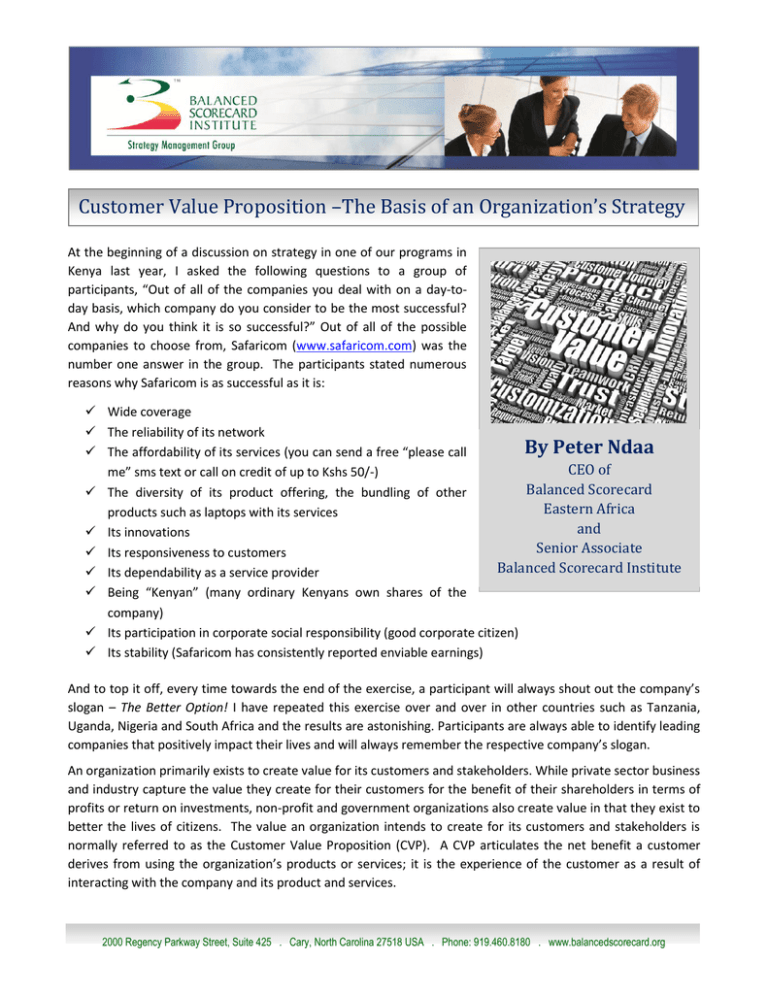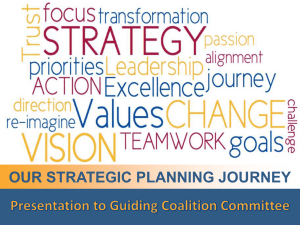
Customer Value Proposition –The Basis of an Organization’s Strategy
At the beginning of a discussion on strategy in one of our programs in
Kenya last year, I asked the following questions to a group of
participants, “Out of all of the companies you deal with on a day-today basis, which company do you consider to be the most successful?
And why do you think it is so successful?” Out of all of the possible
companies to choose from, Safaricom (www.safaricom.com) was the
number one answer in the group. The participants stated numerous
reasons why Safaricom is as successful as it is:
Wide coverage
The reliability of its network
By Peter Ndaa
The affordability of its services (you can send a free “please call
CEO of
me” sms text or call on credit of up to Kshs 50/-)
Balanced Scorecard
The diversity of its product offering, the bundling of other
Eastern Africa
products such as laptops with its services
and
Its innovations
Senior Associate
Its responsiveness to customers
Balanced Scorecard Institute
Its dependability as a service provider
Being “Kenyan” (many ordinary Kenyans own shares of the
company)
Its participation in corporate social responsibility (good corporate citizen)
Its stability (Safaricom has consistently reported enviable earnings)
And to top it off, every time towards the end of the exercise, a participant will always shout out the company’s
slogan – The Better Option! I have repeated this exercise over and over in other countries such as Tanzania,
Uganda, Nigeria and South Africa and the results are astonishing. Participants are always able to identify leading
companies that positively impact their lives and will always remember the respective company’s slogan.
An organization primarily exists to create value for its customers and stakeholders. While private sector business
and industry capture the value they create for their customers for the benefit of their shareholders in terms of
profits or return on investments, non-profit and government organizations also create value in that they exist to
better the lives of citizens. The value an organization intends to create for its customers and stakeholders is
normally referred to as the Customer Value Proposition (CVP). A CVP articulates the net benefit a customer
derives from using the organization’s products or services; it is the experience of the customer as a result of
interacting with the company and its product and services.
2000 Regency Parkway Street, Suite 425 . Cary, North Carolina 27518 USA . Phone: 919.460.8180 . www.balancedscorecard.org
Customer Value Proposition –The Basis of an Organization’s Strategy – Page 2 of 4
Customer value has three dimensions: the physical attribute of the product or services such as price, quality,
speed of delivery and completeness of the service; the relationship that a customer experiences by interacting
with the company; and the emotional appeal of the company or its products and services to the customer.
Customer value is the package of benefits that an organization delivers to its customers through its products and
services. It is the fundamental business philosophy for an organization, the reason they exist. Customer Value
Proposition informs an organization’s purpose to exist, i.e. its mission. Its clarity is the single most important
dimension in strategy.
The choice of value that an organization intends to create for its
customers is at the top of the hierarchy of an organization’s strategic
choices. It is indeed the choice of an organization’s basis of competition.
Expanding on the work of Michael Porter and others in the book, The
Discipline of Market Leaders, Michael Treacy and Fred Wiersema define
three broad ways in which an organization can create value for its
customers: by providing more convenience to customers—by providing
more convenience to customers at low cost, more customized solutions,
or innovative products at the best price. While these three dimensions
of strategy always exist in an organization, the emphasis, at different
periods, will always be on one of them. The challenge for organizations
is the ability to determine when to emphasize the value dimension at
different stages of their life cycles or the industry’s life cycle. Successful
organizations factor the need to change their basis of competition in
their strategic plans either consciously or subconsciously. Let’s go back
to Safaricom, the leading mobile telephone company in Kenya, to
illustrate this.
The challenge for
organizations is the ability to
determine when to
emphasize the value
dimension at different stages
of their life cycles or the
industry’s life cycle.
When Safaricom entered the market in the late 1990s, its emphasis was
on providing mobile communication solutions to corporate clients. Safaricom had very little interest on the
individual customer and in its first three years in the market, it had no post paid service for individuals.
Safaricom’s strategic thrust was evidently to offer customized solutions to corporate clients. While pursuing this
strategy, Safaricom was also aggressively laying down the infrastructure for the mass market. And when the
infrastructure was ready in early 2000s, the emphasis of its strategy changed to low cost and more convenience
to customers–the mass market strategy. This strategy resulted in a revolution in telecommunication in Kenya. As
soon as Safaricom ‘conquered’ the Kenyan mass market in the mid-2000s, its emphasis shifted to innovation, the
most notable innovation being the mobile money service popularly referred to as “M-PESA”. Today, as
competitors struggle to catch up, Safaricom has upped the game and invested heavily in data communication.
Its network had been on 3G for about two years and it aggressively moved to 4G almost a year ahead of its
closest competitor. It has also set up what they call Public TelePresence Rooms (Public TP) in the regional cities
that connect users to other Public TPs in the world. Public TPs are considered to be the new generation
payphones. Safaricom now places a predominant emphasis on providing innovative products at the best prices.
But how can an organization identify, develop and deliver value to its customers? The Balanced Scorecard
Institute’s Nine Steps to Success™ provides a very useful framework for identifying, developing and delivering a
customer value proposition. Some of the key initial tasks in Steps 1 and 2 of the Nine Steps to Success™ are
2000 Regency Parkway, Suite 425 . Cary, North Carolina 27518 USA . Phone: 919.460.8180 . www.balancedscorecard.org
Customer Value Proposition –The Basis of an Organization’s Strategy – Page 3 of 4
customer identification; customer needs analysis and development of a value proposition to satisfy these needs.
In the example of Safaricom above, each of the attributes that were listed above is part of the product/services,
relationship or emotional appeal aspects of its customer value proposition. The customer value proposition
then informs an organization’s mission and vision and influences the selection of strategic themes and results.
Strategic themes are the main focus areas of an organization’s high level strategy—the organization’s ‘pillars of
excellence’. The customer value proposition also influences some game-changing objectives needed to achieve
the strategic results. For more information about strategic themes, results, and objectives, please refer to
Strategic Themes: What are they and How are they Used?
The balanced scorecard strategic planning and management framework will ensure that your organization is
aligned to and executing on your chosen customer value proposition. The balanced scorecard framework aligns
the customer strategy with initiatives, operations and budgets that implement the strategy, and provides
strategic performance measures that provide feedback to evaluate the success of the strategy. The framework
“cascades” the strategy down to the level of teams and individuals, to ensure that everyone in the organization
understands how they contribute to the success of the enterprise. For more information about cascading,
please refer to Cascading a Balanced Scorecard: Creating Alignment.
The process of creating value to your customers is an ongoing process as competitors are likely to keep up with
the benefits you offer. Understanding your customer needs is an ongoing cycle and successful organizations
factor the need to change their basis of competition into their integrated strategic planning and management
system. A dynamic system is a learning system. Step 9 of the Nine Steps to SuccessTM framework is “Strategic
Performance Evaluation.” This is a disciplined approach to evaluating progress toward strategic results as well
as reviewing the underlying strategy itself. It assesses whether your strategies and strategic focus need
adjustment and guides you through the process to assess and make adjustments, as needed. And assessments
of changes to both your organization and the environment in which you operate include an evaluation of the
market, customers/stakeholder value proposition, competition, and other forces. This then leads to a
systematic re-validation of or modification to strategic elements and components of your system in context of
change.
By creating innovative ways to create value to your customers, your organization will be able to differentiate
itself and be one step ahead of your competition. And by integrating these innovations through a disciplined
strategic planning and performance management framework, you will be able to execute quickly and leave the
competition far behind.
2000 Regency Parkway, Suite 425 . Cary, North Carolina 27518 USA . Phone: 919.460.8180 . www.balancedscorecard.org
Customer Value Proposition –The Basis of an Organization’s Strategy – Page 4 of 4
About Balanced Scorecard East Africa (BSEA)
Balanced Scorecard Eastern Africa is a management consulting firm incorporated in Kenya and specialized in strategy
and performance management training and consulting services. BSEA provides training on the balanced scorecard
strategic planning and management system and consulting in business strategy, communication and social marketing.
The firm has worked for companies, government departments and not-for profit organizations of different sizes on value
creation, communication and the development and implementation of balanced scorecards.
About Balanced Scorecard Institute
The Balanced Scorecard Institute provides training, certification and consulting services to commercial, government, and
non-profit organizations worldwide. The Institute applies best practices gained from hundreds of consulting assignments
and 5,000 trainees in balanced scorecard, strategic performance management and measurement, strategic planning,
and change management to help executives, managers and analysts transform their organizations into “performance
excellence” organizations.
©2012 Balanced Scorecard Institute, a Strategy Management Group company. All rights reserved. Do not copy without permission.
************************************************************************************
Peter Ndaa is the CEO of Balanced Scorecard Eastern Africa and a Balanced Scorecard Institute Senior Associate. He has over 20
years of experience as a consultant, practitioner and trainer in the areas of business strategy development and implementation,
business development, financial management, management information systems and human resource management. Peter has
provided training at various BSEA/BSI workshops and facilitated the development of scorecards for both public and private
organizations. He has provided training and facilitation services for several BSEA/BSI clients including the Bank of Uganda (Central
Bank), Commercial Bank of Africa, Central Bank of Nigeria, National Bank of Commerce (Tanzania), CRDB Bank (Tanzania), Volta
River Authority (Ghana), Tanzania Electricity Supply Company (Tanzania), Uganda Finance Trust, Kenya Electricity Generation
Company, East African Portland Cement, the Federal Government of Ethiopia - Ministry of Health (including its agencies, regional
bureaus and Federal Hospitals), the Kenya Red Cross, Strathmore Business School, and IIR (South Africa), amongst others. Peter
holds a Masters of Business Administration degree from Ashridge Business School and is an alumnus of IESE Business School
Global Advanced Management Program. Peter is a fully qualified Certified Public Accountant and Certified Public Secretary.
2000 Regency Parkway, Suite 425 . Cary, North Carolina 27518 USA . Phone: 919.460.8180 . www.balancedscorecard.org



